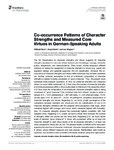Co-occurrence Patterns of Character Strengths and Measured Core Virtues in German-Speaking Adults
| dc.contributor.author | Ruch, W | |
| dc.contributor.author | Heintz, Sonja | |
| dc.contributor.author | Wagner, L | |
| dc.date.accessioned | 2021-03-05T21:46:24Z | |
| dc.date.issued | 2020-11-26 | |
| dc.identifier.issn | 1664-1078 | |
| dc.identifier.issn | 1664-1078 | |
| dc.identifier.other | 599094 | |
| dc.identifier.uri | http://hdl.handle.net/10026.1/16926 | |
| dc.description | No embargo required. | |
| dc.description.abstract |
<jats:p>The VIA Classification on character strengths and virtues suggests 24 character strengths clustered into six core virtues (wisdom and knowledge, courage, humanity, justice, temperance, and transcendence). Three recent studies employed different methods for testing the assignment of character strengths to virtues (e.g., expert and layperson ratings), and generally supported the VIA classification. However, the co-occurrence of character strengths and virtues within individuals has not been examined yet. Another untested assumption is that an individual’s composition of character strengths is related to being considered of “good character.” Thus, the present study addresses three research questions: (1) How do character strengths and measured virtues co-occur within individuals? (2.1) How does the number of character strengths an individual possesses within a virtue cluster relate to their level of the respective virtue? (2.2) How does the composition of an individual’s character strengths relate to being considered of “good character”? We combined data from different studies to obtain a sample of <jats:italic>N</jats:italic> = 1,241 participants (<jats:italic>n</jats:italic> = 897 self-raters, <jats:italic>n</jats:italic> = 344 informant-raters, 70.1% female) aged 18 to 92 years (<jats:italic>M</jats:italic> = 30.64). All participants completed assessments of character strengths and virtues. Regarding (1), we found a high convergence of the correlations between strengths and virtues and the VIA Classification: 22 out of 24 character strengths correlated with the assigned virtue (exceptions were hope, which correlated highest with courage, and humor, which correlated highest with humanity). Also, 15 character strengths showed the numerically highest correlation with their assigned virtue. Regarding (2.1), overall, we found a linear trend between the number of strengths within one cluster and the virtue level. Regarding (2.2), we found higher levels of reported “good character” in those who possessed either (a) at least one character strength in each virtue cluster or (b) all character strengths in at least one virtue compared to those who did not. The present results contribute to the discussion regarding the structure of character: individuals’ character strengths relate to differences in virtues, across different measures and data sources. Relationships were mostly as expected, and deviations were consistent with results obtained using other approaches.</jats:p> | |
| dc.format.extent | 599094- | |
| dc.format.medium | Electronic-eCollection | |
| dc.language | eng | |
| dc.language.iso | en | |
| dc.publisher | Frontiers Media SA | |
| dc.subject | character strengths | |
| dc.subject | virtues | |
| dc.subject | VIA classification | |
| dc.subject | VIA-IS | |
| dc.subject | positive psychology | |
| dc.title | Co-occurrence Patterns of Character Strengths and Measured Core Virtues in German-Speaking Adults | |
| dc.type | journal-article | |
| dc.type | Journal Article | |
| plymouth.author-url | https://www.webofscience.com/api/gateway?GWVersion=2&SrcApp=PARTNER_APP&SrcAuth=LinksAMR&KeyUT=WOS:000597661000001&DestLinkType=FullRecord&DestApp=ALL_WOS&UsrCustomerID=11bb513d99f797142bcfeffcc58ea008 | |
| plymouth.volume | 11 | |
| plymouth.publisher-url | https://www.frontiersin.org/articles/10.3389/fpsyg.2020.599094/full | |
| plymouth.publication-status | Published online | |
| plymouth.journal | Frontiers in Psychology | |
| dc.identifier.doi | 10.3389/fpsyg.2020.599094 | |
| plymouth.organisational-group | /Plymouth | |
| plymouth.organisational-group | /Plymouth/Faculty of Health | |
| plymouth.organisational-group | /Plymouth/Faculty of Health/School of Psychology | |
| plymouth.organisational-group | /Plymouth/REF 2021 Researchers by UoA | |
| plymouth.organisational-group | /Plymouth/REF 2021 Researchers by UoA/UoA04 Psychology, Psychiatry and Neuroscience | |
| plymouth.organisational-group | /Plymouth/REF 2021 Researchers by UoA/UoA04 Psychology, Psychiatry and Neuroscience/UoA04 Psychology, Psychiatry and Neuroscience MANUAL | |
| plymouth.organisational-group | /Plymouth/Research Groups | |
| plymouth.organisational-group | /Plymouth/Research Groups/Plymouth Institute of Health and Care Research (PIHR) | |
| plymouth.organisational-group | /Plymouth/Users by role | |
| plymouth.organisational-group | /Plymouth/Users by role/Academics | |
| dc.publisher.place | Switzerland | |
| dcterms.dateAccepted | 2020-10-14 | |
| dc.rights.embargodate | 2021-3-17 | |
| dc.identifier.eissn | 1664-1078 | |
| dc.rights.embargoperiod | Not known | |
| rioxxterms.versionofrecord | 10.3389/fpsyg.2020.599094 | |
| rioxxterms.licenseref.uri | http://www.rioxx.net/licenses/all-rights-reserved | |
| rioxxterms.licenseref.startdate | 2020-11-26 | |
| rioxxterms.type | Journal Article/Review |


